Bringing Hope to Haiti
Direct Relief International Helps Supply Needed Medicines to a Stricken Country
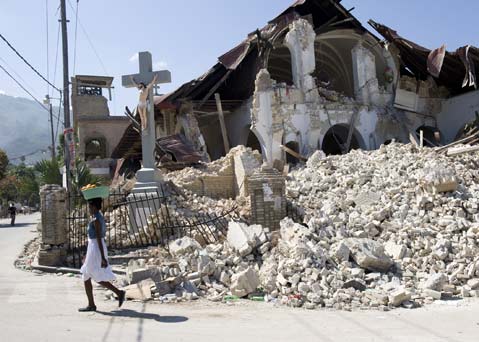
On the small United Nations plane flying to Haiti with Brett Williams and his Direct Relief International (DRI) team, I thought I was, for the most part, prepared for what I would be seeing — I had worked on relief efforts in the aftermath of Pakistan’s 7.6 earthquake, which killed 80,000 people in 2005. But after spending just a week in the capital city, Port-au-Prince, I have come to realize that I had no idea what had really happened there. This earthquake currently ranks as the seventh most deadly natural disaster anywhere, ever, but that sad fact does little to explain how Haiti is suffering. I’m having a hard time finding the right words to describe what I saw and how I felt, both physically and emotionally.
Worn-out is probably the best I can offer: worn-out by the stink of death, which, even weeks after the quake, blows through the city. The body count is as high as 230,000 — roughly the same number of people who live from Carpinteria to Goleta — and thousands of bodies, most of them in Port-au-Prince, still remain buried in the rubble. These bodies were once someone’s mother, someone’s father, someone’s childhood friend.
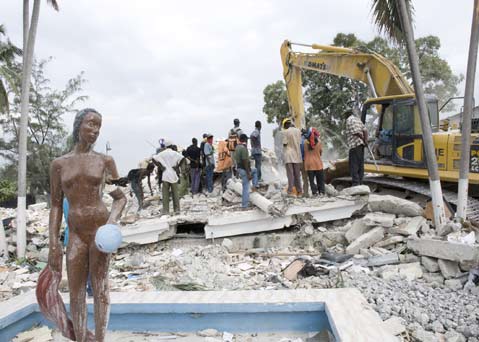
But I also was worn-out from the sun and the heat; worn-out by the sights and sounds of agony emitting from this tiny Caribbean nation; worn-out by the dirty air, the even dirtier water, the raw sewage, the language barriers, the nonexistent infrastructure, and even by the biggest spider I have ever seen, which was in my room on the first night I was there. But for me, a visitor, all this was just a temporary discomfort. For the people of Haiti, it has become their permanent reality.
Take 11-year-old Ishkud Belfour, whose entire family, except for one deranged grandmother, was killed that fateful Tuesday afternoon in January, when the 7.0-magnitude earthquake rocked the city. Orphaned and fleeing from his grandmother, the boy had the sense to admit himself to the Hôpital Sacré Coeur, where he was treated for a broken arm. In the three weeks following the quake, that hospital has treated 3,625 patients, operating on more than half of them. When the DRI team visited last week, the place was packed inside and out, yet amazingly, the building itself seemed to be kept hygienically clean. Outside, what once might have been a pleasant, grassy courtyard, was now crowded with tents where patients were sent to recover after their operations. The tents themselves were taking a beating in the scorching afternoon sun.
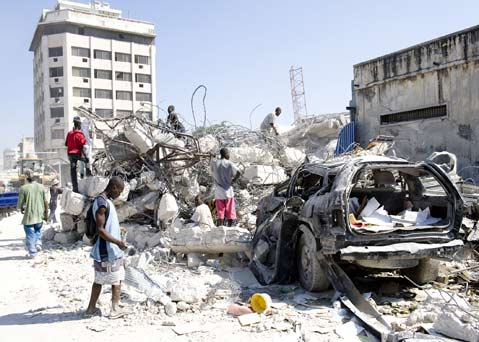
Or take the situation at another hospital, St. Damien, where Cassandra Chapman was volunteering. The young New Zealander, who normally works at an orphanage in the Dominican Republic, described the first chaotic week after the earthquake, when doctors and nurses were struggling to treat 700 injured people in the small, 150-bed hospital. Some of those patients and their surviving families, as well as hospital staff and their families, have taken up residence on the grounds because their homes were destroyed and they have no place to go.
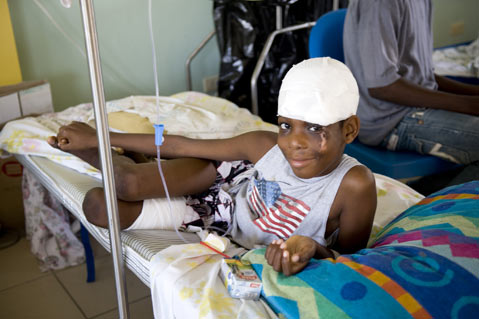
You Are Not Alone
Even before January’s earthquake, Haiti often was described as devastated. A tragic history of natural disasters and corrupt leaders had contributed to making the country the poorest in the Western Hemisphere: Seventy-eight percent of its 8.9 million inhabitants make less than $2 a day; 52 percent of the adult population is illiterate; major infectious diseases are rampant; and the average life expectancy is just 51 years. This all has been compounded by the earthquake, which knocked out whatever was left of the water and sanitation systems, not to mention the entire electrical grid.
The United Nations has had a presence in Haiti since 2004, when it sent 12,000 personnel to increase security. And for the first time in many years, Haiti was beginning to see a sliver of hope — the country was projected to have an economic growth of 4 percent this year. Now, the UN is tasked with the rebuilding effort, and former president Bill Clinton is spearheading the mission. While some experienced relief workers are trying to see the earthquake as an opportunity to right Haiti’s ship, other UN officials wonder if this project is too big even for them. The question becomes, then, if the UN — the largest, most experienced relief organization in the world — can’t do it, who can?
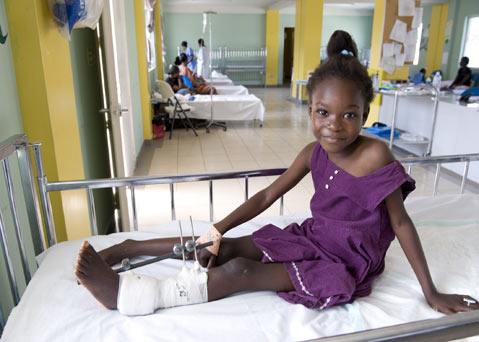
But the response has been tremendous and immediate as the world rallies around Haiti. It’s not just the UN, or the United States military, or the World Health Organization, or the Red Cross working in Haiti, but thousands of individuals as well as agencies: doctors, nurses, trained EMTs, and other emergency responders and volunteers — all of them reaching out to the Haitian people with a unifying message: “You are not alone.” As DRI’s man in Port-au-Prince, Andrew MacCalla, put it, “The whole world is represented in Haiti.”
Direct Relief has been working in Haiti since 1964. In the last decade, it has provided more than $60 million worth of medical supplies to more than 100 Haitian hospitals and clinics that serve the poor, including its four major partners: St. Damien, on the outskirts of Port-au-Prince; Hôpital Albert Schweitzer, in the Deschapelles area of central Haiti, where many people have traveled to escape the destroyed capital; Partners in Health, which has locations throughout Haiti; and Hôpital Universitaire Justinien, in Cap-Haïtien, Haiti’s second-largest city. Because of these relationships, the Santa Barbara-based nonprofit was able to hit the ground running.
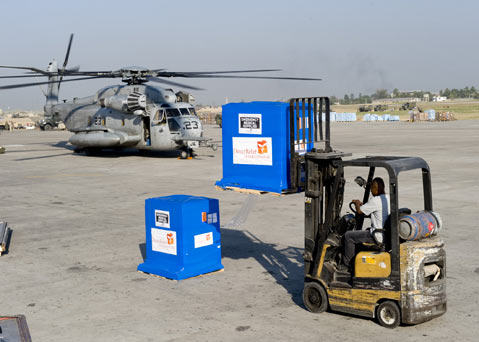
The first supplies DRI sent to Haiti following the earthquake, ironically enough, had been assembled in its Goleta warehouse several months ago, in case the island, which lies in the middle of Hurricane Alley, suffered a storm. When the season ended December 1 without any disaster, DRI decided to send the package anyway, knowing the country could always use the help. By chance, that package, filled with more than $400,000 of essential medical material, arrived the day after the quake. Since then, DRI has sent more than $25 million in wholesale medicine and supplies to its medical partners and clinics throughout the nation, provided to Haitians at no cost. “Our comparative advantage is we already know everybody, we already know where all the health-care sites are,” said Brett Williams, who, as DRI’s director of emergency preparedness and response, first arrived in Haiti three days after the quake. He was returning there to direct the organization’s most ambitious, hands-on relief effort ever undertaken.
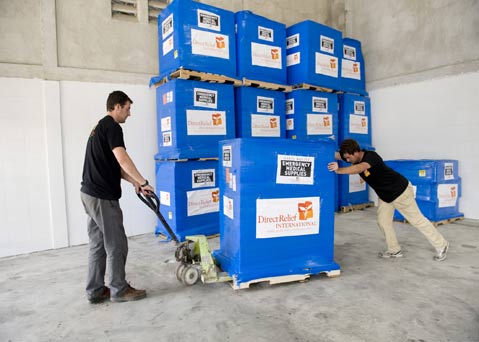
Staying in Haiti
Williams might look like a young, sociable 29-year-old, but he talks with seasoned experience. He has been responding to emergency disasters around the world for five-and-a-half years, including the 2005 earthquake in Pakistan, as well as emergencies in China and Indonesia. And it didn’t take Williams long to realize the Haitian catastrophe was in a league of its own.
Normally, DRI doesn’t stay in-country following a disaster. Though the organization may send in someone to assess the situation, most of the work is done from Santa Barbara, where they coordinate with their already established in-country medical partners, then ship the supplies and medicines actually needed. But Williams quickly understood that wasn’t going to be possible here. The Haitian hospitals and clinics were absolutely overwhelmed with dying and seriously injured patients; the surviving medical staffs, along with hundreds of volunteers from around the world, were working themselves to the bone. No one had time to sit around making lists, let along coordinate with an American group that’s thousands of miles away and trying to send them medicines.
For example, walking through L’Hôpital de la Communauté Haïtienne, a new DRI partner, we saw boxes and boxes of supplies lining the halls, many appearing to have been tossed there arbitrarily and quickly, without much thought. Williams explained that one emergency relief school of thought — not the philosophy DRI adopts — is to send any supplies in stock to poor hospitals and hope they get put to good use. “It often ends up slowing down everything,” he said. Almost on cue, hospital administrator Rob Werner — a short, exhausted-looking American with a scruffy beard, who was sitting at a desk in the middle of the hall directing hospital staff, shooting out emails, welcoming a stream of new volunteers, and generally directing the chaotic hospital traffic in front of his desk — turned to meet the DRI team for the first time. The hospital had had a lot of trucks dropping off supplies, unannounced and unsolicited. “There’re some things we need badly,” Werner said. “We need those specific things, not just anything people want to send.” It was these repeated scenes of chaos and confusion that convinced Williams to establish a more permanent DRI presence in Haiti. Now what Direct Relief needed was a warehouse.
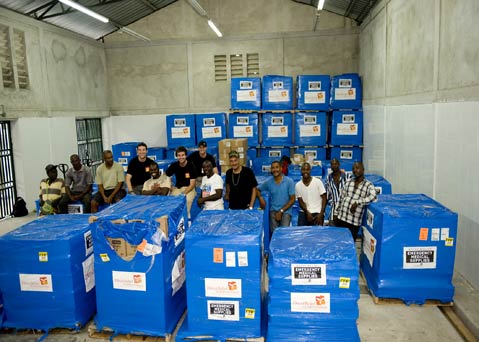
And that’s why Williams returned less than a week later, on February 1, bringing with him MacCalla and Gordon Willcock. The goal: To find a warehouse in or around Port-au-Prince, at or under budget, which could safely house medical supplies, including $16 million worth of medicine arriving on 60 pallets in just four days. MacCalla, who worked for Direct Relief before getting a Master’s degree in public policy, will run the DRI program in Haiti, and Willcock, who works for Australian Aid International (a partner group of DRI), will spend the next three weeks helping MacCalla establish what unofficially has become known as DRIH, Direct Relief International-Haiti.
While looking for the nearly impossible — a safe, reasonably priced warehouse space not already snatched up by larger relief organizations — the DRI team also had to contact old medical partners, establish new relationships with desperately needy clinics and hospitals, coordinate shipments, secure working cell phones and office space, work with other nongovernmental organizations (NGOs) to prevent overlapping relief efforts, and organize the future of DRI in Haiti, which could extend for years. And they had to do all of this while navigating the United Nations Logistics Base — a land of badges and vests; a slow-moving, difficult, complex logistical nightmare involving thousands of agencies and people. But, ultimately, DRI had to deliver to the Haitian people what they desperately need: medicine.
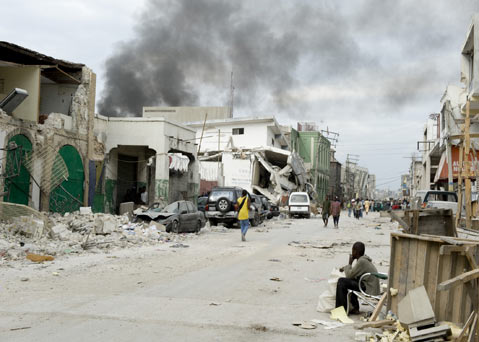
When Total Devastation Is an Understatement
The stories from January 12, 2010, have been told and retold: people just getting off work, hundreds of children in schools, the archbishop of the Catholic Church — all dead; the presidential palace, destroyed. But, weeks later, the aftermath still is overwhelming, and downtown Port-au-Prince continues to look like a warzone. There really is no other way to describe it.
On one of the city’s central thoroughfares, Boulevard JJ Dessalines, you cannot see the pavement, now covered with a one-inch-thick layer of dust and dirt. Roofs are sitting on the ground, entire buildings pancaked beneath them. Electrical wires hang into the street, and the glass from shop windows litters the ground. Some buildings are still standing, but with large cracks and shaky foundations. Gusts of wind blow dust, papers, and the smell of dead bodies throughout the city, while laborers work for $5 a day to remove rubble from a building that once housed a telecommunications company. Other piles of rubble just sit there, untouched since the earthquake; who knows how many bodies are buried beneath them. It is a truly awesome sight. All this destruction was caused in a matter of 30 seconds, but it will take a decade to rebuild.
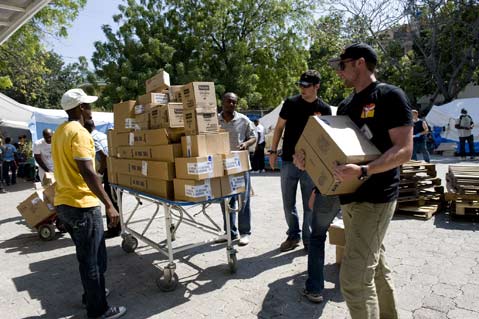
People have partitioned off small parcels of the streets with rocks to designate where they have set up some kind of shelter. Every open pocket of greenery has been filled by tent cities — if you can call these makeshift homes of tarps and sheets “tents.” Few provide adequate protection from the 90-degree heat, and it will be worse when the rainy season arrives in just a few weeks. Thousands have no access to water or sanitation. You can see people relieving themselves on sidewalks, behind trees, everywhere; the pungent smell is a clear warning that infectious disease is a hovering threat. Garbage piles, rotting waste, and stagnant pools of graying water are everywhere. And anywhere you look, you can see hand-painted, scrawled signs, often in English, all some version of the simple plea: “Help us.”
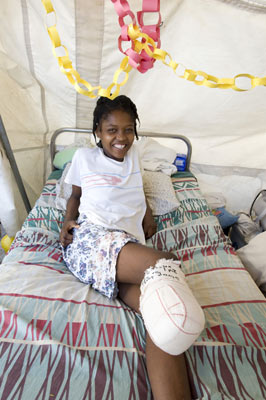
Having a Leg to Stand On
One afternoon outside of St. Damien Hospital, I watched a man struggling to push a woman — presumably his wife, but possibly a relative or maybe someone he didn’t even know — in a wheelchair. Both of her legs were amputated. The man, thin and elderly, was battling foot traffic, car traffic, rocks and stones, and giant potholes that looked wide enough to swallow the entire wheelchair, not to mention the gray, smelly pools of water so deep that the tires disappeared. Because of the earthquake, officials estimate there have been 2,000 amputations of major bones (not fingers or toes), in addition to tens of thousands of major bone fractures. Half of those amputations were performed on people younger than 20 years old.
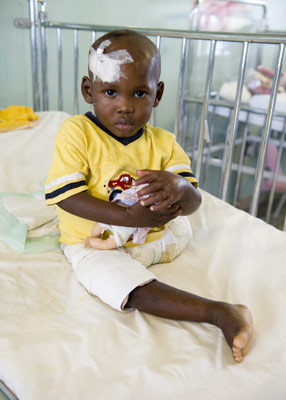
There currently are no prosthetics clinics in Port-au-Prince, and only one part-time facility in the southern part of the country, according to Al Ingersoll of Healing Hands for Haiti. There are groups on the move to help these people who just underwent such an intense, life-altering event, including Handicap International, which plans to deliver 300 temporary prosthetics during the next three weeks. A Leg to Stand On, based in New York City, has a team headed to Haiti later this month to scout out a potential compound for prosthetics and orthotics. There are also reports that Italy wants to build a long-term facility there. Earlier this month, DRI announced it has committed $1.2 million to “support the establishment of prosthetics and orthotics services and the provision of needed assistive devices and rehabilitation to enable long-term response efforts.” It turns out that previously owned and used prosthetics don’t work well for those who have lost limbs recently, but new devices are now available at less than $1,000 each.
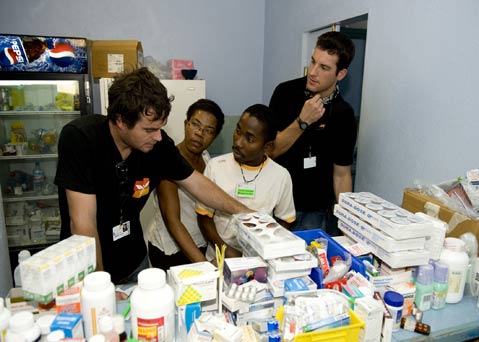
Doing More on Less
The relief response has been so massive in Haiti that it’s easy to see how small groups could get lost in the shuffle. But under the leadership of Thomas Tighe, Direct Relief has been able to grow into an extremely effective, efficient, and nimble international organization. For example, three years ago, a bequest allowed DRI to form a foundation that can now cover all administrative and fundraising expenses. All of the medical supplies are donated by various companies. Recently, FedEx gifted DRI $1 million in free shipping to support the Haitian operation, and six trailers for transporting supplies in Port-au-Prince were donated by Baxter Healthcare. In other words, Direct Relief is doing a lot more work for a lot less money, perhaps getting more medicine to more Haitians than any other relief organization.
DRI, which regularly is listed among America’s most financially efficient charities, leverages between $21 and $37 of medical material and aid for each dollar donated. Last year, DRI shipped out $250 million in wholesale medicine and supplies from its 50,800-square-foot Goleta warehouse. The core supporters of DRI are from the Santa Barbara area, and, until six years ago, when it ramped up its national visibility via its Web site, nearly all of DRI’s support came from Santa Barbara. Now, donations come in from all 50 states and around the world to support programs both abroad and right here in the U.S., where Direct Relief, since 2004, has given $150 million in medicines and supplies to more than 1,000 partner clinics and health center entities. Donations earmarked for Haiti — more than $4.5 million, as of now — are being spent as straight donations to medical and clinical partners, as well as for the warehouse.
Make Me an Offer
The first real lead on a warehouse came from Jean Baptiste Joseph Junior — known to everyone simply as “Junior” — a strong, thickly built Haitian who works for the UN. Junior is a kind of jack-of-all-trades — you need a driver, he knows a driver; you need a warehouse, he knows a guy with a warehouse. Junior has a side business, an event company, which provides deejays, speakers, and music to parties and weddings, but, as he put it, “There isn’t no music right now.” Eventually, Direct Relief secured a temporary space at a World Health Organization facility, where DRI was able to house six shipping containers while distributing the contents.
Emergency response logistics involve constant networking and communications. It’s fascinating to see how small the world becomes when international emergency relief agencies convene, and — from the head man at the UN Logistics Base (where all aid planning is located centrally) to field workers with Dr. Paul Farmer’s Partners in Health — the DRI staff stays on the grid. Even I, a friend of Williams’s who thought I had a good grasp on the work he does, was impressed with his ability to connect with the people needed to get things done, his personality a perfect fit for the job.
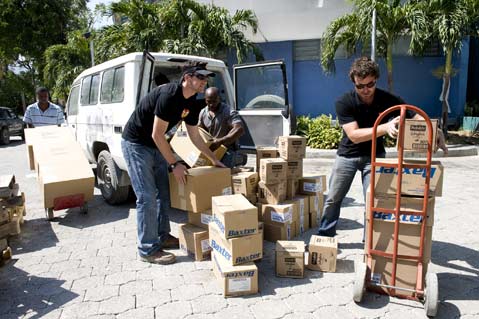
Watching the DRI team finally locate a real warehouse was interesting. In some vague and unspecified way, Junior was instrumental in setting up a meeting with the owner of one of Haiti’s largest water and ice manufacturers, Pino Eau Nationale. Wilhem Blanchard, a well-dressed, well-groomed man, greeted the DRI team at the warehouse on his expansive campus very pleasantly, saying just seconds into the meeting, “You guys are coming in to help my country, so we can make it work.” After a bit of back-and-forth bargaining, everyone settled on $4,000 per month to rent the 34×54-foot secure space, which also includes use of staff, a loading dock, lifts, and trucks. They are hopeful the warehouse will be used far into the future, and DRI is looking actively for a Haitian manager to run the daily in-country operations. But for now, the deal came in the nick of time, just 14 hours before the first DRI delivery arrived.
The next day, Williams, MacCalla, and Willcock were on the tarmac at the airport with their newly acquired trucks and drivers. In front of them was a spectacular sight indeed: Sixty pallets, some weighing in excess of one ton and the majority filled with medication to help children with diarrhea caused by dirty water, were wrapped in blue shrink-wrap and stacked one on top of the other. Plastered over the pallets, which contained $16 million in emergency medical supplies, were big stickers reading, “Direct Relief International.” Williams could hardly contain his excitement, exchanging high-fives with his team and practically jumping for joy.
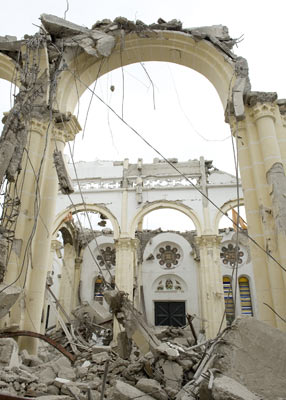
There is no doubt that Haiti will be needing help for the next decade, and organizations like DRI are digging in for the long haul. On this hot, sunny afternoon, Blanchard, decked out in a polo shirt and designer jeans, along with DRI staff and the poor warehouse laborers were all working busily, unloading the pallets into the new DRI space. The Haitian people have endured so many tragedies and been betrayed by their own leaders so many times that they are facing this catastrophe with a strength of self-reliance and resoluteness that has become part of their national character. As our 57-year-old driver, Serge Henry Jean — who has lived through so many of those governments and so many natural disasters — told me, “The Haitian government is like a father who can’t take care of his son.” But, sitting in the back of his truck and watching tons of medicine being loaded into the new warehouse, he concluded, “My people are very strong. Yeah, they are very strong.”



